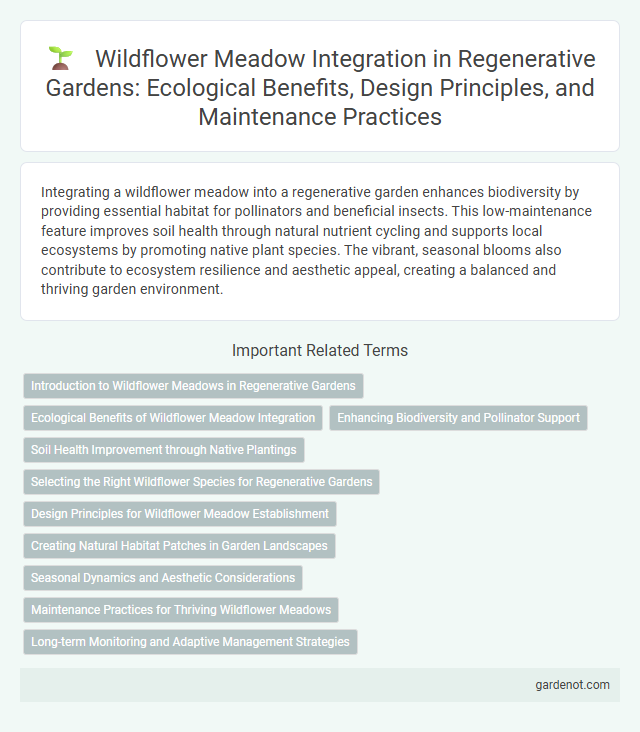Integrating a wildflower meadow into a regenerative garden enhances biodiversity by providing essential habitat for pollinators and beneficial insects. This low-maintenance feature improves soil health through natural nutrient cycling and supports local ecosystems by promoting native plant species. The vibrant, seasonal blooms also contribute to ecosystem resilience and aesthetic appeal, creating a balanced and thriving garden environment.
Introduction to Wildflower Meadows in Regenerative Gardens
Wildflower meadows play a vital role in regenerative gardens by enhancing biodiversity and supporting pollinators such as bees, butterflies, and native insects. Incorporating a mix of native wildflower species fosters soil health through natural nitrogen fixation and reduces the need for chemical fertilizers. This integration creates resilient ecosystems that improve water retention and provide habitat connectivity within garden landscapes.
Ecological Benefits of Wildflower Meadow Integration
Integrating wildflower meadows in regenerative gardens enhances biodiversity by providing essential habitats for pollinators such as bees, butterflies, and native insects, which support ecosystem stability. These meadows improve soil health through root systems that increase organic matter and prevent erosion, while also enhancing water retention and filtration. The diverse plant species contribute to carbon sequestration and create a resilient ecosystem that withstands environmental stress and supports local wildlife populations.
Enhancing Biodiversity and Pollinator Support
Integrating a wildflower meadow within a regenerative garden significantly boosts local biodiversity by providing diverse habitats for native insects, birds, and small mammals. The variety of flowering plants ensures continuous bloom cycles, offering critical nectar and pollen sources for pollinators such as bees, butterflies, and hoverflies throughout the growing season. This rich ecological niche supports pollinator populations, enhances cross-pollination for adjoining crops, and strengthens overall ecosystem resilience.
Soil Health Improvement through Native Plantings
Integrating wildflower meadows with native plantings significantly enhances soil health by boosting microbial diversity and increasing organic matter content. Native deep-rooted species improve soil structure, promote water infiltration, and reduce erosion, creating a more resilient and fertile ecosystem. This natural approach to regeneration supports nutrient cycling and carbon sequestration, making wildflower meadows a crucial component in sustainable garden design.
Selecting the Right Wildflower Species for Regenerative Gardens
Selecting the right wildflower species for regenerative gardens enhances biodiversity, supports pollinators, and improves soil health. Native wildflowers like Echinacea, Black-eyed Susan, and Purple Coneflower thrive in local climates and require minimal maintenance, promoting ecological balance. Incorporating diverse species with staggered bloom times ensures continuous habitat and food sources for beneficial insects throughout the growing season.
Design Principles for Wildflower Meadow Establishment
Design principles for wildflower meadow establishment emphasize soil condition assessment, native species selection, and spatial planning to enhance biodiversity and ecosystem resilience. Incorporating diverse seed mixes tailored to local climate and soil types promotes pollinator habitats and supports wildlife corridors. Maintenance regimes prioritize minimal disturbance, seasonal mowing, and invasive species control to sustain meadow health and regenerative growth cycles.
Creating Natural Habitat Patches in Garden Landscapes
Integrating wildflower meadows into regenerative garden landscapes enhances biodiversity by providing essential habitat patches for pollinators and native wildlife. These natural habitat zones support the life cycles of bees, butterflies, and other beneficial insects, promoting ecological balance. Establishing diverse wildflower species enriches soil health and fosters resilience against environmental stressors.
Seasonal Dynamics and Aesthetic Considerations
Incorporating a wildflower meadow into a regenerative garden enhances seasonal dynamics by supporting pollinator activity and biodiversity peaks throughout spring, summer, and early autumn. Selecting native wildflower species with staggered blooming periods ensures continuous visual interest and habitat provision. Aesthetic considerations include varying plant heights and colors to create layered textures and seasonal shifts that attract wildlife while enriching the garden's natural beauty.
Maintenance Practices for Thriving Wildflower Meadows
Regular mowing and selective weeding prevent invasive species from outcompeting native wildflowers, ensuring a diverse plant community. Seasonal cutting, timed after seed set, promotes healthy regrowth and sustains pollinator habitats throughout the year. Incorporating soil health assessments and organic mulch applications enhances nutrient cycling, supporting resilient wildflower meadow ecosystems.
Long-term Monitoring and Adaptive Management Strategies
Long-term monitoring of wildflower meadows involves regular assessment of plant species diversity, soil health, and pollinator activity to ensure ecosystem resilience. Adaptive management strategies include altering mowing schedules, introducing native species, and controlling invasive plants based on monitoring data. These approaches optimize biodiversity, enhance habitat quality, and promote sustainable regeneration in garden ecosystems.
Wildflower meadow integration Infographic

 gardenot.com
gardenot.com